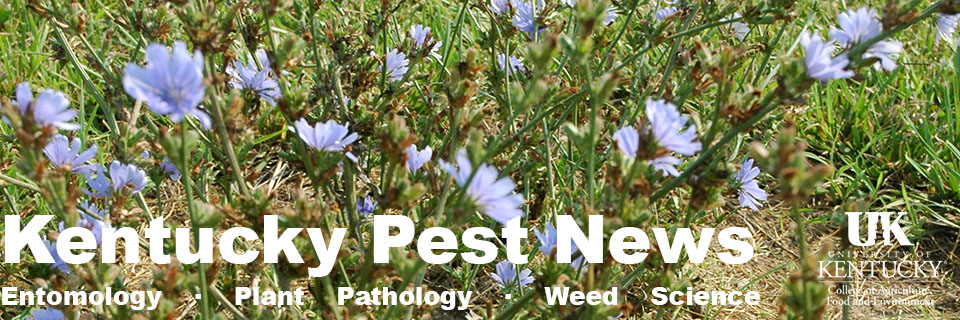Several issues in soybean can cause leaf tissue to turn yellow and brown between the veins, while the veins remain green. These symptoms are known as interveinal chlorosis and necrosis. This article describes some of the diseases and disorders currently…
Monthly Archives: August 2017
Steal Magnolias
The magnolia scale, about 1/2 inch in diameter, is a soft scale that feeds on magnolias. Undetected infestations steal sap and vigor from landscape trees while covering foliage with honeydew and the resulting sooty mold. Heavily infested trees (Figure 1)…
Wasp and Bee Magnets
Fallen, rotting fruit, along with plants infested with aphids and other sap-feeding insects, attract yellow jackets, hornets, paper wasps, bees, and flies that are looking for a late season “sweet fix.” Management Options Here are some ways to try to…
Featured Publications
New Publications on Grain Crop Diseases Available through Crop Protection Network and University of Kentucky. Over 25 new publications on grain crop diseases are now available through the multi-state research and Extension group, the Crop Protection Network (CPN). The CPN…
Plant Disease Diagnostic Lab Highlights
The following plant disease highlights from the University of Kentucky Plant Disease Diagnostic Laboratories represent recent sample submissions from field crops, fruit, vegetables, and ornamentals. Diagnostic samples of agronomic crops from the past two weeks have included Stemphyllium leaf spot…
2017 Insect Trap Counts
Trap counts for major insect pests are provided by the Kentucky IPM Program. Traps are located at the UK Research and Education Center in western Kentucky and the UK Spindletop Farm in Lexington. Below are trap counts for the current…
Featured Publication
Volutella Blight of Boxwood PPFS-OR-W-26 Volutella blight (also called Pseudonectria canker) is the most common disease of boxwood in Kentucky landscapes and nurseries. This disease is caused by an opportunistic fungal pathogen that attacks leaves and stems of damaged or…
2017 Insect Trap Counts
Trap counts for major insect pests are provided by the Kentucky IPM Program. Traps are located at the UK Research and Education Center in western Kentucky and the UK Spindletop Farm in Lexington. Below are trap counts for the current…
True and Fall Armyworms and Black Cutworms May Be Causing Some Damages in Corn and Pastures in Kentucky
Male adult moths of the true armyworm (Mythimna unipuncta), fall armyworm (Spodoptera frugiperda), and black cutworm (Agrotis ipsilon) have been captured in increased numbers during the last couple of weeks in pheromone-based traps in Princeton (Figure 1). As individual species,…
Controlling Corn Earworm on Sweet Corn
One of the more challenging crops to keep insect-free is sweet corn, especially with later plantings that ripen after early August. The key pest is corn earworm, which remains hidden in the tip of the ear until the ear is…
Late-Season Pests of Tomatoes
There is little that compares to the flavor of a vine-ripened tomato. But insect damage to the fruit will definitely reduce the experience. Two groups of late-season pests are common and frequently need to be managed. The first group is…
Woolly Aphids
Elm, silver maple, apple hawthorn, and serviceberry often have colonies of woolly aphids living on the undersides of their leaves (Figure 1) in spring. Initially, they clearly look like aphids, but they take on a fluffy appearance later in their…
Sawflies – Late Season Pine Defoliators
Sawflies are members of the same insect order (Hymenoptera) that includes ants, bees, and wasps. The larval stage has a caterpillar-like body that may be brightly marked with stripes or spots. Some species change significantly in appearance as they grow,…
Bumble Bee Discord
Two reports of bumble bee attacks last week were reminders that these industrious insects do not like a lawn mower passing over or too near their nests, and they will come out to register complaints. Most of our common bumble…
Featured Publication
Flowering Dogwood Diseases (PPFS-OR-W-06) The flowering dogwood (Cornus florida) is one of the most popular ornamental trees in Kentucky landscapes. Unfortunately, some common diseases can threaten the health of dogwood in both residential and commercial settings. This publication covers spot…
